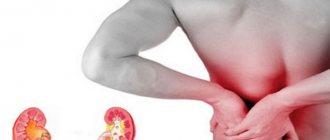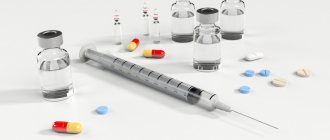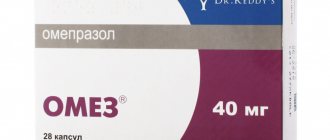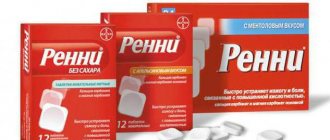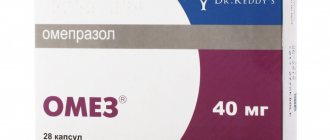Ulcerative lesions of the duodenum or stomach with a whole bunch of concomitant diseases: reflux esophagitis and other pathologies of the intestinal part of the digestive system are not uncommon. Especially gastritis, delay in treatment of which leads to gastrointestinal ulcers.
Medicine appeals with effective medications, not only for healing the source of the disease, but also for further protecting the mucous membrane of the digestive tract. De-Nol and Venter tablets are in high demand among them.
Comparison of the effectiveness of Venter and De-nol
The effectiveness of Venter is quite similar to De-nol - this means that the ability of the drug substance to provide the maximum possible effect is similar.
For example, if the therapeutic effect of Venter is more pronounced, then using De-nol even in large doses will not achieve this effect.
Also, the speed of therapy - an indicator of the speed of therapeutic action - is approximately the same for Venter and De-nol. And bioavailability, that is, the amount of a drug reaching its site of action in the body, is similar. The higher the bioavailability, the less it will be lost during absorption and use by the body.
Characteristics of De-Nola
It is a gastroprotector that effectively protects the gastric mucosa. Dosage form: tablets. The active ingredient is bismuth tripotassium dicitrate. The medication strengthens the protection of the gastric mucosa and restores it after damage. The peculiarity of the drug is that it is able to destroy a specific bacterium that causes peptic ulcers and gastritis.
We recommend reading: How to use Reamberin for pancreatitis?
In combination with other antibacterial agents, it shows a high degree of cleansing the body of this microorganism (up to 94%). This results in good effectiveness in the treatment of stomach ulcers, gastritis and duodenum. With long-term use of the medication, Helicobacter does not develop resistance to it.
De-Nol has the following effects:
- forms a protective film, preventing irritation of the mucous membrane by gastric juice and accelerating the process of scarring of the ulcer;
- strengthens the natural protective barrier of the mucous membrane;
- reduces the activity of the gastric enzyme, reducing its damaging effects on the cells of the gastric mucosa;
- improves blood circulation through the capillaries of the gastric mucosa, which leads to the acceleration of metabolic processes in cells, promoting the rapid restoration of damaged tissues;
- impairs the ability of bacteria to attach to the mucosa;
- violates the integrity of the bacterial cell membrane;
- leads to suppression of enzyme activity inside the microorganism;
- reduces the aggressiveness and mobility of the microbe.
Indications for use:
- stomach and duodenal ulcers;
- gastroduodenitis;
- chronic and acute gastritis;
- functional dyspepsia;
- irritable bowel syndrome accompanied by diarrhea.
The course of treatment lasts 4-8 weeks. After completing therapy, you should not take medications that contain bismuth for 2 months. This is a moderately toxic element, which, with prolonged use, accumulates in the body, causing damage to many systems and organs.
De-Nol strengthens the natural protective barrier of the gastric and intestinal mucosa.
Most often, the medication is well tolerated, but the following side effects may develop:
- nausea, vomiting, change in stool color, darkening of the tongue, diarrhea;
- urticaria, skin rash, itching;
- with long-term use of the drug in large doses, encephalopathy and brain damage are observed, which is accompanied by a decrease in memory, attention, etc.
In case of overdose, bismuth poisoning may develop. It is accompanied by the following symptoms: abdominal pain, nausea, vomiting, black border on the gums, diarrhea, flatulence. Renal function is often impaired, leading to renal failure.
Comparison of safety of Venter and De-nol
The safety of a drug includes many factors.
At the same time, in Venter it is quite similar to De-nol. It is important where the drug is metabolized: drugs are excreted from the body either unchanged or in the form of products of their biochemical transformations. Metabolism occurs spontaneously, but most often involves major organs such as the liver, kidneys, lungs, skin, brain and others. When assessing metabolism in Venter, as well as in De-nol, we look at which organ is the metabolizing organ and how critical the effect on it is.
The risk-benefit ratio is when the prescription of a drug is undesirable, but justified under certain conditions and circumstances, with the obligatory observance of caution in use. At the same time, Venter does not have any risks when used, just like De-nol.
Also, when calculating safety, it is taken into account whether only allergic reactions occur or possible dysfunction of the main organs. In other matters, as well as the reversibility of the consequences of using Venter and De-nol.
Characteristics of Venter
The drug Venter can be bought in pharmacies in tablet form or in the form of granules. It contains sucralfate in combination with an aluminum complex, acting as the active substance of the drug.
The most important of the medicinal properties of Venter is the ability to create a protective film in areas of damage to the mucous membrane of the diseased organ. This significantly accelerates the scarring of the eroded area, also preventing the resumption of damage to its integrity.
Venter is recommended for treatment of biliary lesions of the digestive organs and caused by salts and acids of the gastric juice. The drug does not have a systemic effect, working within the gastrointestinal tract.
Gastroprotector Venter is indicated for use as part of complex treatment in the following cases:
- ulcer (damage to the stomach/duodenum);
- reflux disease;
- high levels of phosphates in the blood;
- as a prophylactic against stress-type gastric ulcers, or during prolonged use of antibiotics.
Venter tablets do not affect the viability of the known bacterium Helicobacter in the stomach.
This is a drug with low absorption, the main part of which is excreted by the intestines. Only minor excretion is carried out by the kidneys.
When considering the warnings of drug interactions, a doctor when prescribing Venter for treatment should take into account its properties in relation to other drugs for their joint use:
- with Tetracycline, Thyroxine, Ranitidine, Phenytoin, Cimetidine, Digoxin, Theophylline, Quinidine, Ketoconazole, Warfarin and fluoroquinolones - the absorption of these drugs is reduced (an interval of at least two hours will be required);
- Aluminum hydroxides and citrates taken simultaneously with Venter can provoke an increase in the concentration of aluminum in the blood.
Among the adverse events noted:
- the digestive system may develop nausea, diarrhea or constipation, sometimes dry mouth;
- in the central nervous system, patients complain of headaches, drowsiness and dizziness;
- an allergic reaction is expressed in skin rashes, itching or the development of urticaria;
- Among other side effects, pain in the lower back was noted.
Comparison of habituation in Venter and De-nol
Like safety, addiction also involves many factors that must be considered when evaluating a drug.
So, the totality of the values of such parameters as Venter’s “syndrome” is quite similar to the similar values of De-Nol. Withdrawal syndrome is a pathological condition that occurs after the cessation of intake of addictive or dependent substances into the body. And resistance is understood as initial immunity to a drug; in this it differs from addiction, when immunity to a drug develops over a certain period of time. The presence of resistance can only be stated if an attempt has been made to increase the dose of the drug to the maximum possible. At the same time, Venter’s “syndrome” values are quite small, however, the same as De-nol’s.
Composition, action and why it is prescribed for ulcers
De-Nol is a drug that has a protective effect on the gastric mucosa.
The drug refers to substances that have a protective effect on the gastric mucosa.
The main active ingredient is tripotassium bismuth dicitrate. The drug is produced exclusively in tablet form.
In appearance they are white or cream colored tablets. Sometimes they emit a slight smell of ammonia. This is not considered a sign of damage.
De Nol has an antibacterial effect on the microorganism Helicobacter pylori. This pathogen is the culprit of inflammatory processes on the mucous membrane, stomach and duodenal ulcers.
In the stomach, under the influence of hydrochloric acid, bismuth is deposited on the mucous membrane and forms chelate compounds with proteins. These substances cover the mucous membrane with a dense film, thus protecting it from the corrosive effects of hydrochloric acid.
The components of the drug promote the accumulation of growth factor for the epidermis of the mucous membrane. This promotes healing of areas of erosion. The drug is not absorbed, does not penetrate into the general bloodstream and is excreted in the feces.
Comparison of side effects of Venter and De-nol
Side effects or adverse events are any adverse medical event that occurs in a subject after administration of a drug.
Venter's state of adverse events is almost the same as De-nol's. They both have few side effects. This implies that the frequency of their occurrence is low, that is, the indicator of how many cases of an undesirable effect of treatment are possible and registered is low. The undesirable effect on the body, the strength of influence and the toxic effect of Venter are similar to De-nol: how quickly the body recovers after taking it and whether it recovers at all.
Description of the drug Venter
The drug Venter is used in the treatment of erosions in the stomach and ulcers; the drug accelerates the healing of damage and prevents relapses. An important advantage of the drug is that it does not have a systemic effect, showing activity only within the gastrointestinal tract.
The drug forms a protective coating at the site of ulceration, preventing further negative effects on the site of damage by gastric juice and digestive enzymes. Indications for use:
- treatment of ulcerative lesions of the stomach and duodenum;
- to prevent the appearance of ulcers;
- if long-term use of non-steroidal anti-inflammatory drugs is necessary.
Comparison of ease of use of Venter and De-nol
This includes dose selection taking into account various conditions and frequency of doses. At the same time, it is important not to forget about the release form of the drug; it is also important to take it into account when making an assessment.
The ease of use of Venter is approximately the same as De-nol. However, they are not convenient enough to use.
The drug ratings were compiled by experienced pharmacists who studied international research. The report is generated automatically.
Last update date: 2020-12-04 13:43:44
Contraindications for use
The prescription of both drugs, both De-Nol and Venter, is not carried out:
- when the patient is found to be intolerant to the components of the drug;
- in the presence of severe renal dysfunction;
- for pregnant women and nursing mothers;
- in childhood (De-Nol up to 4 years old, Venter up to 14 years old).
Venter tablets are contraindicated for patients with hypophosphatemia, Alzheimer's disease and for abdominal pain of unknown origin. There is no need to rush into prescribing this medicine for those who suffer from intestinal disorders such as diarrhea or constipation.
When is it indicated?
De-Nol is used to treat diseases of the stomach and intestines.
The drug is used in the treatment of various diseases of the stomach and intestines. The drug is indicated in the following cases:
- Erosion processes in different parts of the gastrointestinal tract, including those provoked by Helicobacter pylori
- Gastitis and duodenitis of various etiologies, including those associated with Helicobacter pylori
- Dyspepsia not associated with inflammatory processes in the gastrointestinal tract
- Irritable bowel syndrome
There are few contraindications to the use of De Nol. Tablets are not used in the following cases:
- Individual intolerance
- Children under 6 years old
- Pregnant and lactating women. If the drug is indicated for use, then lactation should be stopped for this period.
- Uncompensated renal failure
- Rules of administration and symptoms of overdose
The dose of De Nol is selected depending on the patient’s age and the severity of the disease. While taking this remedy, it is prohibited to take other bismuth preparations. Effective dosages:
- Children from 4 to 8 years old – 1–2 tablets per day
- Children from 8 to 12 years old – 2 tablets per day – morning and evening
- From 12 and older – 1 tablet 4 times a day or 2 times 2 pcs. in the morning and in the evening
The drug is taken half an hour before meals. The duration of treatment is from 1 to 2 months. Then a break is taken from taking bismuth-containing medications for 8 weeks.
The drug may turn stool black. Darkening of the tongue is also observed. This is not an indication for discontinuation of the drug.
It is forbidden to take De Nol simultaneously with tetracycline drugs. This reduces the effect of the antibiotic. Taking any medications, food, milk, juices is prohibited within 30 minutes after taking De Nol.
The drug should not be taken above the recommended dose and for more than 8 weeks. Long-term use leads to kidney failure. There is no specific treatment, but the use of antacids and laxatives is indicated. In severe cases, you should undergo a course of hemodialysis.
